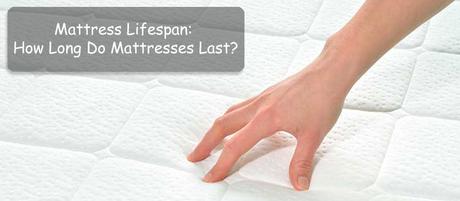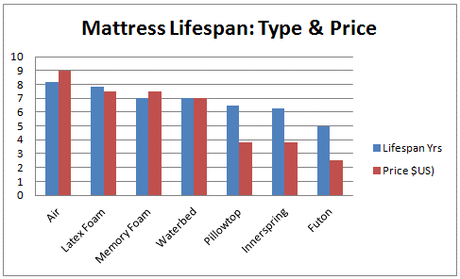The term 'mattress lifespan' refers to the length of time that a mattress retains acceptable support and comfort. They can be expensive to replace, so most people tend to use theirs for as long as possible. This is often way beyond their useful life. So how long do mattresses last and what difference is there between the various types of the mattress?

Here is some information about the average expected longevity of various type of mattress, why they lose comfort and support and what you can do to make your mattress last as long as possible.
Table of Contents
How Long Should a Mattress Last
How long should a mattress last and how long does a mattress last are not always the same. Like all household items, mattresses deteriorate as they age. The rate of deterioration and the lifespan of a mattress depends on many factors including the materials used in their manufacture, how well they are constructed, how vigorously they are used and the care and maintenance given to them.
A foam mattress can have an average life from 10 - 20 years according to how they are made and used, while an innerspring mattress lifespan is around 10 - 15 years with average use. However, the terms 'can', 'should' and 'does' are rarely the same when mattress longevity is concerned.
How long does a mattress last when looked after properly? When cared for correctly many mattresses can last a lot longer than average, some up to 15 - 20 years. It is possible to increase the life of some mattresses by using a mattress topper. That is because the comfort layer is generally the first to go. That said, the average mattress should last around 10 - 15 years - closer.
Let's look at some of the factors that help some mattresses last longer than others. We shall first look at the various mattress types available, what factors lead to them degrading, and then what you can do to extend their average lifetime.
There are many different types of mattress marketed worldwide, many being hybrids and mixtures of the regular standard foams. We shall discuss here only the more common types of mattress and how long they can normally be expected to offer the level of comfort and support you require of them. We shall begin with a regular innerspring mattress.
Recommended Reading: How Often Should You Change Your Mattress? "
Innerspring Mattress Lifespan
The mattress lifespan of innerspring beds is largely dependent on the number and gauge (thickness) of the springs. For that reason, it is not realistic to make a comprehensive statement of what the lifespan of such mattresses should be. There are several different ways in which spring coils can be incorporated into a mattress. They can be:
- Pocket Coil: Each coil is wrapped in fabric and operates independently of its neighbors. Motion is isolated to a large extent, and the support is distributed consistently to those areas of your body that require it (hips, buttocks, shoulders, knees, etc).
- Continuous Springs: Springs are created by a continuous wire that runs from head to toe of each coil and then continues onto creating the next coil. In other words, the spring is fashioned from one continuous steel wire. That means that support is not isolated to those coils in contact with the person. Each coil in the mattress will be taking a part of the weight and movement of the users.
- Open Coils (Bonnell): An open coil mattress, know as a Bonnell coils, is manufactured in the form of hourglass coil springs linked by a spiral wire running over the top and the bottom of the spring unit, linking each coil together. There is also a single retaining wire top and bottom to strengthen the integrity of the spring unit.
Innerspring mattresses are favored by couples that enjoy a bouncy bed which is particularly suitable for sex. That and sleep are the two main purposes of a bed or mattress, and both must be taken into consideration. The pocketed coil mattress has the least bounce in this respect.
Innerspring mattresses have a relatively short life. Springs tend to weaken over time, and those springs under most pressure will weaken first. This leads to sagging of the mattress, particularly where the hips and other pressure points have the most contact with the springs.
Effect of Coil Gauge and Coil Count: The thickness of the coils is rated in gauge, usually between 12 and 15 gauge. The higher figure represents a thinner coil. The thicker the coils, or lower the gauge, the longer your mattress will last. Also, at the same gauge, the more coils in the mattress the better. However, the number of coils is not as important as the support and comfort the mattress provides.
Coil gauge and count are two reasons why it is not possible to provide an accurate comparison of the longevity of different types of mattress. For maximum life, choose a mattress with a lower gauge coil, no more than around 12.5, and a good number of coils - an average of 725 for a queen size mattress.
Latex Foam Mattresses Lifespan
How long do mattresses last if they contain no springs? Some may think they should last a lot less than a spring mattress because the foam is weaker than a set of springs! However, this is not the case. Latex foam can maintain its strength and level of support longer than the average spring mattress.
Some latex mattresses have a number of layers, any one of which can be replaced when it wears and loses its comfort or support properties. However, extended use of latex foam mattresses can lead to permanent impressions of the users sleeping body shape. This does not mean that the level of support has deteriorated, but it can significantly reduce the ease of movement on the mattress.
Memory Foam Mattress Lifespan
A memory foam mattress tends to conform to the users sleeping position. By doing so, its lifetime is generally greater than that of a spring or latex mattress. However, like any other mattress, memory foam does wear, and it can ultimately lose its 'memory' and sag, losing support as it does so. It may also form a permanent impression of the user's body shape that cannot be restored to the original flatness.
Air Mattress Lifespan
An air mattress can go wrong in a number of ways. They can develop leaks due to valve failure or punctures. Leaks and breakdown of the air pump has led to many issues with air bed users. Because of this, air beds tend not to last as long as others. However, because the various components of air beds can often be repaired, their longevity, as opposed to their relatively poor durability, can be technically quite high.
Futon Mattresses and Floor Mattress Lifespan
A futon mattress lifespan tends to be lower than average. However, a foam or innerspring futon may last longer than other types of the futon, though perhaps not as long as regular mattresses. Any mattress can be used on the floor, although its lifespan may be less than the same mattress lying on a properly designed bed base.
Hybrid Mattresses Lifespan
A hybrid consists of elements of more than one mattress type. For example, an innerspring mattress with a latex foam top layer can significantly extend the life of the mattress. Some are designed with a memory foam layer over a layer of latex foam. By combining the benefits of the different mattress types, it is possible to maximize the properties of each.
Waterbed Mattress Lifespan
A waterbed mattress is very similar to an air mattress in that it can go wrong in a number of ways. Again, valve failure and leaks can reduce the longevity of a waterbed. Irrespective of the claims of manufacturers, the realistic life of a waterbed is around 8-9 years. Some may last longer and others less.
Floor Mattresses Lifespan
Floor mattresses are generally futons, although you can simply place any of the mattress types above on the floor. How long should a mattress last on the floor? That's difficult to say, but you can take it that it will be less than on a base designed to take some of the pressure applied to the mattress itself. A floor accepts very little or none of the pressure applied to the mattress when in use.
Pillow top Mattresses Lifespan
Pillow top mattresses consist of two tiers. The support section is the bottom tier and is fundamentally just any type of mattress: box spring, foam or pocket spring. The pillow top section comprises any soft top such as polyester, latex foam wool or even memory foam. It is a soft layer that provides a comfortable feel to the mattress.
Rather than a pillow top mattress, you could use a topper on your mattress, such as a feather or down topper or even a thin memory foam. A major issue with pillow top mattresses is that the bottom side has no topper or comfort layer, so when your mattress wears you cannot flip it. Even though the support part is still functional, you will need to replace the top if you want your mattress to last. This is where a topper can increase the life of your mattress.
Crib Mattress Lifespan
It is difficult to assess the lifespan of a crib or cot mattress. This is because of the way young children use their crib or cot. If they bounce a lot on it, the mattress will have a lower lifespan than if they just sleep and lie on it. We cannot, therefore, give a genuine crib mattress lifespan. However, they should last around 4 years or more if looked after properly. Rotate them each season, and flip them every other season. Use a waterproof crib mattress cover and change the sheets at least weekly.
The longest-lasting types of crib mattress are innerspring and pocket coil mattresses with a coil gauge of 12.5 or lower. The thicker wire promotes longer life. Some foam mattresses also provide a good life but make sure the foam is hard and is GREENGUARD children and schools certified indicating that it emits no harmful fumes.
How Long Do Mattresses Last: Mattress Lifespan Chart
The lifespan of a mattress varies according to type, as discussed above, and to price. You cannot expect a low-cost mattress to last as long as one at the higher end of the price range. The chart below indicates the average life of a selection of mattress types at the average price for each. You can purchase mattresses a lot cheaper, but they will likely not attain the average life displayed:

Note: Lifespans are relative, 100 being a maximum though close to the realistic useful mattress lifespan. Prices are shown at around 50% of the actual price in $100 units on the graph. So, a memory foam mattress lasts without significant loss of comfort around 7 years and costs an average of $1500 US.
Summary: How Long Should Mattresses Last

The lifespan of a mattress depends a great deal on the type of mattress and also the way it is made. A well-constructed innerspring mattress with the last longer than one made to a lower standard of workmanship. In general, however, the above averages apply - you will always get better and poorer examples of each type of mattress and cheaper and more expensive examples.
You may prefer a memory foam or latex mattress for you and your family to a spring mattress, but the above averages apply. Once you believe you have chosen the best type of mattress, then consider the relative factors above such as coil count, foam thickness and hyouess and so on. Then make your choice. Many mattresses are expected to last up to 20 years, but a mattress lifespan depends on how you use it and how you look after it.
Continue Reading: Mattress Disposal: How to Get Rid of a Mattress "

